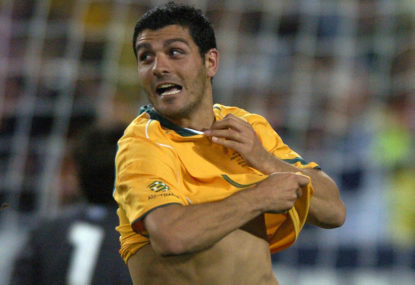Young excellence, promotion battles, and a happy farewell: The Australian team of the week from players around the globe
Even though St.Pauli ultimately lost a high-scoring affair, Jackson Irvine was a standout, as well as scoring a late goal.

The Football Federation of Australia (FFA) has announced that it will be closing its Centre of Excellence (originally AIS Men’s Football) at the Australian Institute of Sport in Canberra at the end of the year. It is worth reflecting on the contribution of the AIS men’s program to football in Australia.
Men’s football was one of the original eight residential sports when the AIS was established in 1981 in Canberra.
Two Englishmen were given responsibility of developing young players – former Socceroos coach Jimmy Shoulder as Head Coach and Ron Smith as his assistant.
The football program was set up as a development program with the aim of developing players for the Young Socceroos (U20), Olyroos and ultimately the Socceroos.
The AIS program had some immediate results in developing national players such as Frank Farina, Oscar Crino and Tony Franken.
In the early years, many AIS players gravitated to the National Soccer League (now A-League) and some to the major leagues in Europe.
In observing the team in the early days, it was set up like a professional club in terms of coaching and training but players were also expected to study or work outside training.
The ultimate goal of football in Australia is to compete in the World Cup.
The Socceroos first played in the 1974 World Cup and just missed out on qualifying several times before John Aloisi’s penalty shootout goal against Uruguay at Sydney Olympic Stadium sent them to the 2006 World Cup in Germany.
The 2006 Socceroos World Cup team included 11 former AIS players – John Aloisi (1992 scholarship), Marco Bresciano (1997), Brett Emerton (1995-1996), Joshua Kennedy (1998-1999), Mark Milligan (2002), Craig Moore (1992-1993), Lucas Neill (1994-1995), Josip Skoko (1992-1993), Mile Sterjovski (1996-1996), Mark Viduka (1992-1993) and Luke Wilkshire (1998).
The Socceroos qualified for the 2010 World Cup in South Africa and that included 12 former AIS players – Lucas Neill (captain) (1994-1995), Craig Moore (1992-1993), Brett Emerton (1995-1996), Luke Wilshire (1998), Joshua Kennedy (1998-1999), Adam Federici (2002), Vince Grella (1996-1997), Carl Valeri (2000-2001), Nikita Rukavytysa (2005-2006), Mark Milligan (2002), Dario Vidosic (2005-2006), Marco Bresciano (1997)
The 2014 Socceroos World Cup team in Brazil included 7 formes AIS players – Marco Bresciano (1997), James Holland (2006-2007), Mitchell Langerak (2005-2006), Matthew McKay (2000-2001), Mark Milligan (2002), Matthew Spiranovic (2006), and Dario Vidosic (2005-2006)
The decline in the number of former AIS players in the 2014 World Cup team may have been behind the FFA’s decision to disband the Centre of Excellence program.
Major changes that have impacted on the program in the last decade included the move to Dutch coaching with the appointment of Jan Versleijen in 2008, difficulties in AIS players transitioning to A-League due to its higher standard and the AIS decision through the Winning Edge policy to transfer responsibility for funding the program in 2013 to the FFA.
As someone who has watched the AIS men’s football program over the years, I believe the 1990s was its strongest period.
During this period, it was under the control of Head Coaches Ron Smith (1986-1996) and Steve O’Connor (1996-2008).
It is also interesting to note that the 1990s was the strongest era at the AIS in Canberra due to its increased commitment to high-performance sport in the lead-up to the Sydney Olympics.
I thought I might have a go at selecting an all-time AIS World Cup Team from players who have represented Socceroos at the World Cup.
AIS Starting Eleven
Goalkeeper – Adam Federici
Defenders – Lucas Neill, Craig Moore, Luke Wilshire, Matthew Spiranovic
Midfield – Brett Emerton, Marco Bresciano, Vince Grella, Carl Valeri
Strikers – Mark Viduka, John Aloisi
Substitutes – Josip Skoko, Mark Milligan, Mile Sterjovski, Matthew McKay, Joshua Kennedy, Dario Vidosic, Mitchell Langerak (goalkeeper)
Players unlucky no to make the team due their Socceroos teams not qualifying for World Cup include Frank Farina, Oscar Crino, Tony Franken, Ned Zelic, Kevin Muscat, Paul Trimboli, Jade North and Warren Spink.
I did not include Josip Šimunić as he only represented Croatia at the World Cup.
Robbie Kruse most likely would have made the 2014 World Cup team but was ruled out due to injury.
Off the pitch, AIS players have contributed to the development of football particularly in relation to coaching and media.
Players that have made coaching contributions at an international and national level include Frank Farina (Soccer’s Head Coach 1999-2005), Kevin Muscat (Melbourne Victory), John Aloisi (Melbourne City/Brisbane Roar), Ray Junna (Canberra United W League), Robert Hooker (Canberra United W League), Alistair Edwards (Perth Glory) and John Gibson (Perth Glory W League). Numerous players have been assistant coaches in the National Soccer League and A-League.
Craig Foster and Ned Zelic play significant roles in promoting football in the Australian media.
Finally, a little-known fact is that Craig McLatchey, an inaugural scholarship holder who career was cruelled by a knee injury, went on to become the CEO of Swimming Australia and Australian Olympic Committee in the 1990’s.
The AIS has definitely contributed to the rise of the Socceroos since the 2000s.
I hope that the FFA remains committed to strong development programs that assist young players in transitioning into the A-League and then to leading overseas competitions such as EPL, Serie A and La Liga. This commitment should result in having successful Socceroos teams.